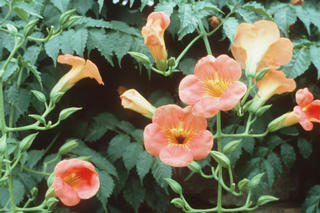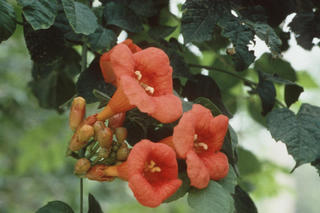Campsis grandiflora
Contents
Nomenclature
Other Names:
Historical Use of Campsis grandiflora
Campsis grandiflora in Traditional Chinese Medicine
Background
Chinese Name (pinyin): Lingxiaohua
Chinese Name :
Common Name :Trumpetcreeper flower
Specific Name : Flos campsis
Scientific Name:
Collection : The drug is collected at flowering in summer and autumn and dried.
Description : Flower of Campsis grandiflora: Frequently shrunken and curved, yellowish brown to dark brown, the whole one, 4-5cm long, calyx tube campanulate, 2-2.5cm long, 5 lobed up to the middle of calyx tube, bearing 5 longitudinal lines from the base of the calyx tube to the apex of calyx tooth, corolla 5-lobbed at the apex, lobes hemicircular connected at the lower part, funnel shaped with fine striations of the surface, relatively distinct on the inner surface, stamens 4, didynamous, inserted on the corolla tube, anthers shaped, style 1, stigma flat, odour slightly aromatic, taste slightly bitter and sour.Flower of Campsis randicans: The whole one, 6 - 7cm long, calyx tube 1.5 -2cm long, coriaceous, 5 toothed at the apex, the teeth short triangular about 1/3 in length of calyx tube, longituninal lines on the outer surface of calyx tube indistinct. Ther inner surface of the corolla tube bearing distinct, dark brown striations.
Identification : Yellowish brown, pollen grains subrounded, 24 - 31µm in diameter with 3 furrows, surface bearing extremely fine reticulate striations. Grandular hairs yellowish or yellowish brown, head ellipsoid, subrounded or oval, 1 - 2 layer of cells palisade-like arranged in lateral view, stalked 1 - 3 celled. Epidermal cells of corolla subpolygonal, spiral vessels vesible.
Processing :
Action : To promote blood circulation and remove blood stasis, to remove heat from the blood and dispel wind.
Indication :
Precautions :
Dosage : 5 to 9 g.
Storage : Preserve in a ventilated and dry place, protected from moisture.
Synonymns for Campsis grandiflora
Patent Medicines and Medicines with Multiple Ingredients that include Campsis grandiflora
Pharmaceutical Information
Chemical Constituents
Evidence or the Use of Campsis grandiflora in the Treatment of Epilepesy
Basic Science
Animal Studies
Cohort, Case-Control and Non-Randomized Trials
Randomized Controlled Trials
Meta-Analysis
1st Five Results: pubmed search
Hongqin Li, Liqiang Wang, Changhao Ma
##Title##
Mitochondrial DNA B Resour: 2023, 8(11);1200-1204
[PubMed:38239913]
[WorldCat.org]
[DOI]
(I e)
Francis E Putz
Climbing plants beat trees to soil nutrient patches.
Curr Biol: 2023, 33(12);R675-R676
[PubMed:37339592]
[WorldCat.org]
[DOI]
(I p)
Hiu-Lam Ngai, Bobby Lim-Ho Kong, David Tai-Wai Lau, Pang-Chui Shaw
Differentiation of Lingxiaohua and Yangjinhua by chloroplast genome sequencing and DNA barcoding markers.
Genome: 2023, 66(2);21-33
[PubMed:36516431]
[WorldCat.org]
[DOI]
(I p)
Xianheng Ouyang, Jiangling Pan, Zhitao Wu, Anliang Chen
Predicting the potential distribution of Campsis grandiflora in China under climate change.
Environ Sci Pollut Res Int: 2022, 29(42);63629-63639
[PubMed:35461417]
[WorldCat.org]
[DOI]
(I p)
Haimei Chen, Zhuoer Chen, Qing Du, Mei Jiang, Bin Wang, Chang Liu
Complete chloroplast genome of Campsis grandiflora (Thunb.) schum and systematic and comparative analysis within the family Bignoniaceae.
Mol Biol Rep: 2022, 49(4);3085-3098
[PubMed:35059974]
[WorldCat.org]
[DOI]
(I p)

